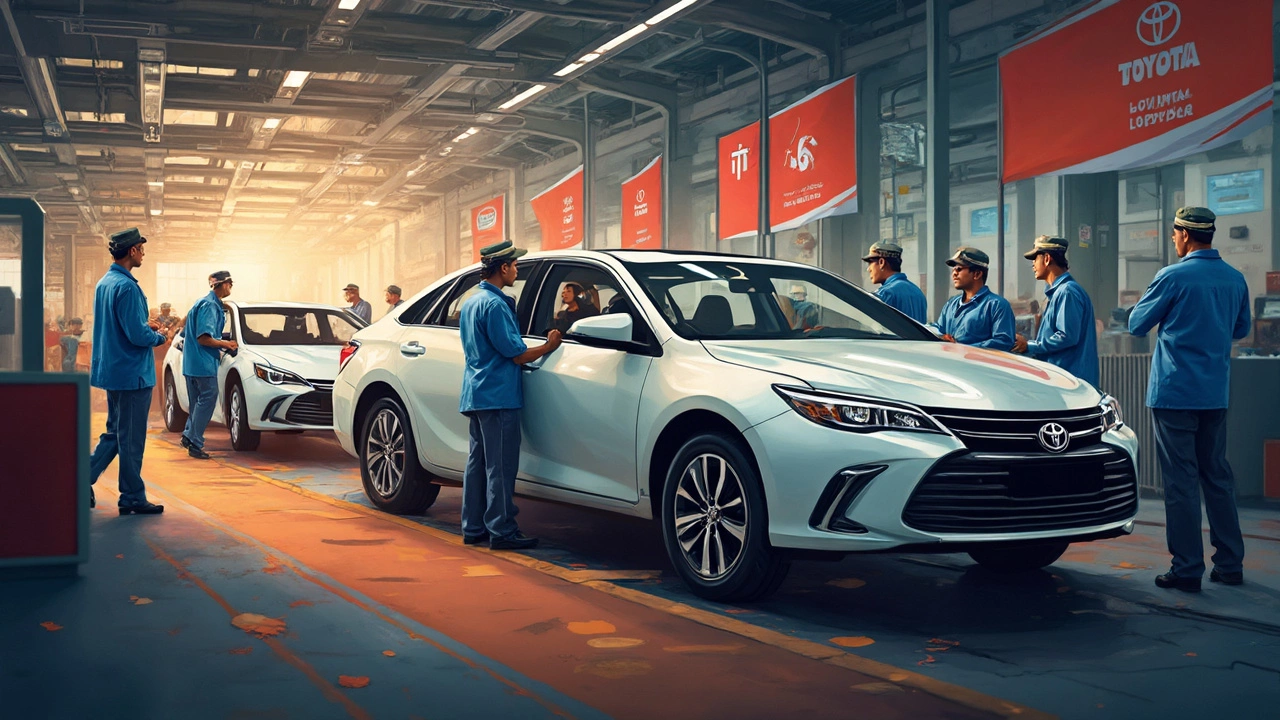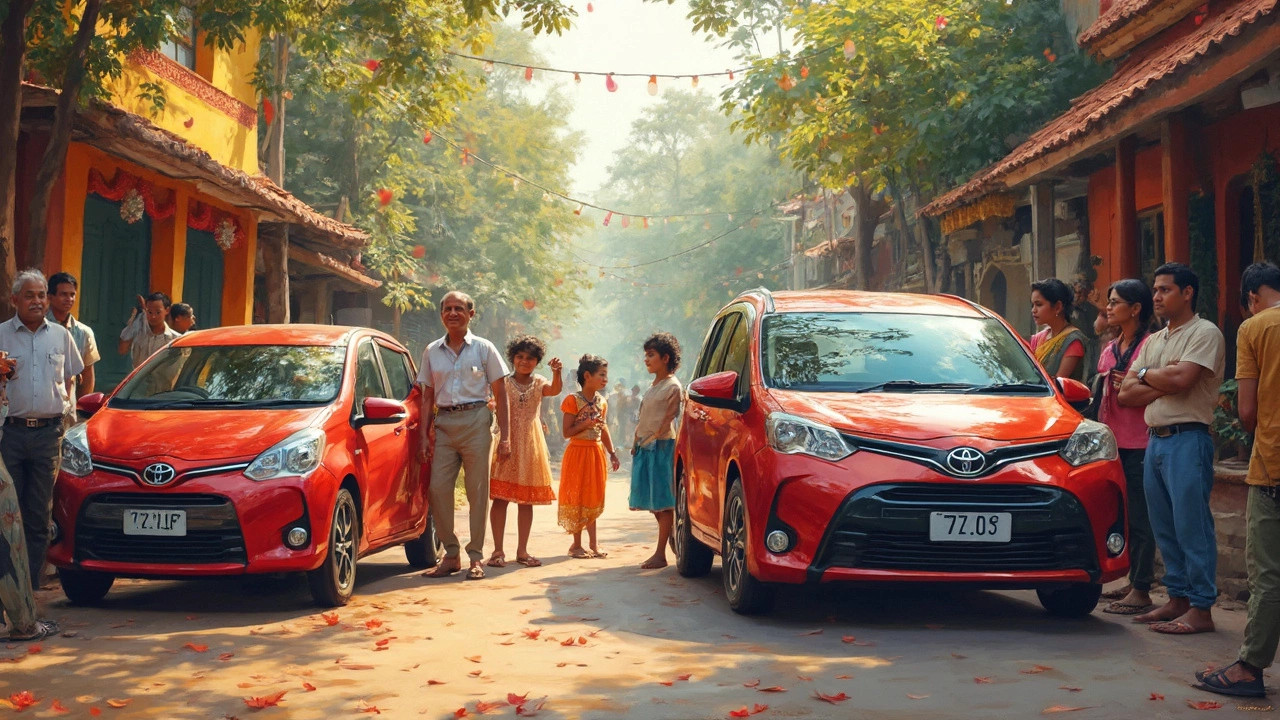Who Bought Toyota to India? The Story Behind India's Toyota Revolution

If you’ve ever waited at a traffic light in India, you’ve probably counted at least one Toyota Innova or Fortuner nearby. But here’s a question most people don’t ask: who actually brought Toyota to Indian roads? The answer isn’t as simple as Toyota just wanting a bit of the action. It’s got plenty to do with a lesser-known Indian company, a global car giant looking for a new home, and some pretty smart moves in the late ’90s.
For a long time, India’s car scene was basically a mix of Ambassadors, Marutis, and the odd Fiat. Global brands just didn’t want to risk it here, thanks to strict rules and a not-so-friendly import policy. Toyota watched from the sidelines for years before making a move. So, what changed? The Indian market finally opened up a bit in the 1990s, and suddenly, the timing looked right.
The twist? Toyota didn’t come here alone. Their real entry into India happened through a key partnership with Kirloskar Group, a well-established Indian industrial company. This partnership—Toyota Kirloskar Motor—was signed in 1997, and that one decision set the stage for all those robust Toyotas we see everywhere today.
- Toyota's First Entry: When and Why
- The Kirloskar Connection: The Real Game-Changer
- How the Joint Venture Changed Indian Roads
- The Early Models: What Worked (and What Didn't)
- Toyota in India Today: Tips for Buyers
Toyota's First Entry: When and Why
It all kicks off in the late ’90s, a wild time for Toyota and the Indian automobile scene alike. Before this, India’s car industry was pretty much local, and most international names stayed away because of tough import rules and sky-high tariffs. So, why did Toyota finally jump in? Well, the simple answer is the Indian government started loosening restrictions on foreign investment in automobile manufacturing, and Toyota didn’t want to miss out on a giant, fast-growing market.
The official green light came in 1997. That’s when Toyota signed an agreement with Kirloskar Group, setting up a joint venture: Toyota Kirloskar Motor Private Limited (often called TKM). This move was about more than just selling cars—they wanted to actually build them in India. By doing this, Toyota met the new government requirements, reduced costs, and could make cars suited for Indian roads (translation: they needed to survive potholes and long drives in the heat!).
Here’s a quick rundown of what was going on back then:
- Indian car market was growing, but most buyers wanted something reliable and affordable.
- The first Toyota factory in India was set up in Bidadi, Karnataka—an area known for its industrial growth and good access to transport.
- Production officially began in 1999, and the first model rolled off the line soon after: the Toyota Qualis. If you’ve seen old-school cabs or family wagons in India, you probably know this vehicle. It looked simple but was famous for handling rough conditions better than most rivals.
Check out how the Indian car scene changed once Toyota came in:
| Year | Major Event |
|---|---|
| 1995 | Foreign direct investment rules relaxed |
| 1997 | Toyota announces joint venture with Kirloskar |
| 1999 | Toyota Qualis launch, first Indian-made Toyota |
The big takeaway? Toyota’s entry didn’t just mean more cars on the road. It forced other companies to step up their game, pushed for better technology, and made reliability a must-have feature for Indian buyers. Toyota’s bet paid off big time because they tailored their approach for India, instead of just dropping in overseas models and calling it a day.
The Kirloskar Connection: The Real Game-Changer
The honest answer to who brought Toyota to India? Kirloskar Group. This Indian powerhouse isn’t just famous for pumps and engines—their major leap was teaming up with Toyota, and this move changed the whole Indian automobile manufacturing game. In 1997, Kirloskar Group inked a joint venture deal with Toyota, and that's when Toyota Kirloskar Motor Private Limited (TKM) was born.
This wasn’t your standard handshake partnership. Kirloskar held an 11% share while Toyota took the majority, giving the Japanese brand a clear path to set the rules and maintain global standards. But Kirloskar’s local roots and know-how made it possible to cut through India's red tape and establish manufacturing in Bidadi, near Bengaluru. That location isn’t random—it sits close to auto parts suppliers and a tech-savvy talent pool.
Here’s what made this partnership such a big deal for both sides:
- Toyota got access to India’s fast-growing middle class, without dealing with endless licensing hassles on their own.
- Kirloskar gained a respected global partner, which meant next-gen tech and quality standards came right into their ecosystem.
- Together, they set up a massive production facility—over 400 acres—ready to roll out models built for Indian roads and conditions.
This partnership clicked because both sides knew the local car market was about more than just selling cars—it was about building trust and keeping prices competitive. Thanks to this joint effort, Toyota could avoid the high costs of imports and start manufacturing right here, keeping their cars within reach for Indian buyers.
| Year Joint Venture Formed | Initial Investment (USD) | Plant Location |
|---|---|---|
| 1997 | ~330 million | Bidadi, Karnataka |
It’s no surprise that after this move, other global car brands watched closely and followed suit, but Toyota had already snagged a prime spot in the Indian market. Ask anyone at a local mechanic’s shop or among auto dealers: the Toyota-Kirloskar story is textbook stuff for business schools.

How the Joint Venture Changed Indian Roads
When Toyota teamed up with Kirloskar, things got real for the Indian car scene. Until then, most cars were either tiny hatchbacks or boxy old sedans. The first car to roll out of the new Toyota Kirloskar Motor plant in Bidadi, Karnataka was the Qualis in 2000. It didn’t look fancy, but it was tough, reliable, and perfect for large Indian families and taxi fleets. People were hooked—the Qualis sold over 50,000 units before Toyota retired it in 2005.
This wasn’t just about one car. The joint venture brought in Toyota’s famous focus on quality, durability, and customer service. Service centers popped up in smaller cities, which was rare at the time. Mechanics got real training, and parts became more accessible and affordable. Suddenly, owning a Toyota in India didn’t mean endless waiting for repairs or imported parts.
The roads started to look different. You’d spot Qualis dominating school drop-offs and group trips, Innova becoming the go-to family mover, and later, the Fortuner changing what people expected from an SUV. Toyota’s manufacturing here helped create jobs and boost local suppliers—a win for the economy as well.
Here’s a quick look at Toyota’s early impact with real numbers:
| Model | Launch Year | Units Sold in First 5 Years |
|---|---|---|
| Qualis | 2000 | ~50,000 |
| Innova | 2005 | ~120,000 |
| Corolla | 2003 | ~30,000 |
What’s wild is, as the roads changed, so did the way people thought about automobile manufacturing and ownership in India. People started expecting smoother rides and lower maintenance—a huge leap from the rickety cars of earlier decades. The Toyota touch set a new bar, and other car makers had to step up their game, making it a win for everyone who drives in India today.
The Early Models: What Worked (and What Didn't)
When Toyota first teamed up with Kirloskar and jumped into the Indian scene, they didn’t just roll out any global model and hope for the best. Their first attempt was the Qualis in 2000, which wasn’t exactly flashy, but boy, did families, businesses, and even taxis snap it up. Why? It was sturdy, easy to fix, and almost bulletproof on bad roads. People valued reliability over fancy looks, and the Qualis hit that sweet spot.
If you’re thinking of early Toyota success stories in India, Qualis is usually the first car that pops up. Back then, it quickly rolled ahead of rivals like Tata Sumo and Mahindra Bolero. But what few remember is that the Qualis was actually based on an older model that had already run its course overseas. It just fit perfectly with what Indian customers needed at the time—space, ruggedness, and value.
But not everything Toyota tried worked out. After Qualis, came the Corolla and the Camry. While the Corolla worked wonders for middle-class folks who wanted a little status and peace of mind, the Camry was too expensive and a bit too posh for most Indian buyers. People loved the Corolla’s mix of fuel efficiency and easy maintenance. The Camry, though, mostly just sat in showrooms.
Here’s how the early years looked for Toyota’s Indian portfolio:
| Model | Launched | Why It Worked (or Didn't) |
|---|---|---|
| Qualis | 2000 | Sturdy, spacious, perfect for families and taxi fleets |
| Corolla | 2003 | Comfortable, reliable, hit with professionals |
| Camry | 2002 | Too pricey, limited market appeal |
| Innova | 2005 | Instant favorite for long-distance families and business users |
In 2005, the Innova took over where the Qualis left off. The Innova stuck to the same formula—rugged, reliable, easy to live with—but updated it with more comfort and better looks. Today, you still spot Innovas everywhere from highways to wedding processions. If you’re ever on the fence about buying a used early-2000s Toyota in India, chances are it’ll have a reputation for racking up high mileage with zero drama—especially the Qualis and Innova.
One thing Toyota didn’t quite crack early on? The small-car market. They focused bigger first because that’s where customers actually had the money and the need. It wasn’t until a bit later with models like the Etios and the Liva that they seriously targeted the budget crowd.

Toyota in India Today: Tips for Buyers
You’ll spot a Toyota in every part of India—cities, highways, and even remote villages. The brand built its solid reputation here with reliable cars like the Innova, Fortuner, and the smaller Glanza. If you’re considering buying a Toyota, here’s what actually matters right now.
First off, new car prices can be a shock. Thanks to tough competition and local assembly, though, Toyota’s keeping things sensible in most segments. In 2025, the Innova Hycross, Hyryder, and Glanza are grabbing a lot of buyers. The Innova Hycross, for example, starts around ₹18 lakh; it’s pricier than some rivals, but ask any cabbie why they prefer it and you’ll hear about low running costs and cars that easily cross 2 lakh km. Maintenance is still cheaper compared to most European brands.
Let’s talk about after-sales. Toyota’s service network is huge—over 400 authorized service centers and growing. Spare parts are easy to get and not as expensive as you might fear. Plus, they’re fast. Most regular services finish in a couple of hours if you book in advance. Toyota also runs an official used car program called “Toyota U Trust,” which checks cars more thoroughly than most, so don’t ignore the certified used options.
Buying tips? Here’s what’s actually useful:
- Check resale value: Old Toyotas still fetch good money. An Innova can get you over 60% of its original price even after 5 years if you’ve taken care of it.
- Go hybrid if you drive in the city: Models like the Urban Cruiser Hyryder hybrid offer great fuel economy—up to 27.97 km/l (certified).
- Look for year-end offers: Like most brands, Toyota India clears inventory with discounts in December and March.
- Ask about waiting periods: Some models, especially the Fortuner and Hycross, can have wait times stretching to a few months, so plan ahead.
- Service packages matter: Toyota’s prepaid service plans can save money, especially if you plan to keep the car past 3 years.
| Popular Toyota Models in India (2025) | Starting Price (Ex-Showroom, ₹) | Mileage (ARAI, km/l) |
|---|---|---|
| Innova Hycross | 18,00,000 | 16-23.2 |
| Fortuner | 33,00,000 | 10-14.2 |
| Glanza | 6,81,000 | 22.3-30.61 |
| Hyryder Hybrid | 11,89,000 | 27.97 |
Bottom line: Toyota still nails it in India for buyers who want reliability, easy ownership, and solid resale. If you want flashy features or risky tech, you might look elsewhere, but if you just want a car that works and lasts, you’re in the right place.